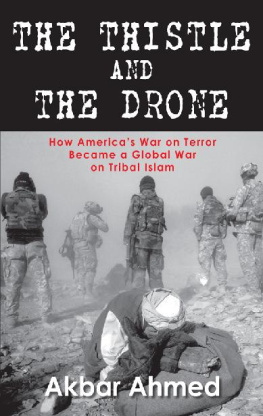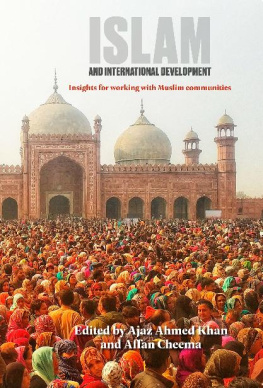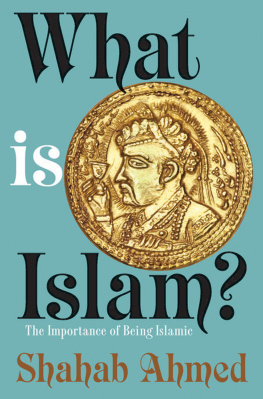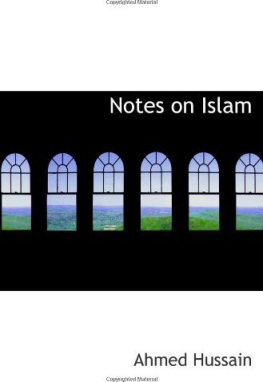How Americas War
on Terror Became
a Global War
on Tribal Islam
A KBAR A HMED
For
A LEXANDER A KBAR A HMED
with love
CONTENTS
2 Waziristan:
The Most Dangerous Place in the World
3 Bin Ladens Dilemma:
Balancing Tribal and Islamic Identity
4 Musharrafs Dilemma:
Balancing Center and Periphery
5 Obamas Dilemma:
Balancing Security and Human Rights
6 How to Win the War on Terror:
Stopping a Thousand Genocides Now
Appendix:
Of Tears and Nightmares
T HE T HISTLE AND THE D RONE
T he Jonas Brothers are here. Theyre out there somewhere, a smiling and confident President Barack Obama told the expectant and glittering audience attending the White House Correspondents Dinner in Washington on May 1, 2010. Sasha and Malia are huge fans, but boys, dont get any ideas. I have two words for you: predator drones. You will never see it coming. You think Im joking?
Obamas banter may have seemed tasteless, given that he had just been awarded the Nobel Peace Prize, but this was not a Freudian slip. The president was indicating he possessed Zeus-like power to hurl thunderbolts from the sky and obliterate anyone with impunity, even an American pop group. One report said he had a love of drones, noting that by 2011 their use had accelerated exponentially. I wondered whether the learned selectors of the Nobel Peace Prize had begun to have second thoughts.
As its use increased, the drone became a symbol of Americas war on terror. Its main targets appeared to be Muslim tribal groups living in Afghanistan, Pakistan, Yemen, and Somalia. Incessant and concentrated strikes were directed at what was considered the ground zero of the war on terror, Waziristan, in the Tribal Areas of Pakistan. There were also reports, however, of U.S. drones being used against other Muslim tribal groups like the Kurds in Turkey and the Tausug in the Philippines, and also by the United Kingdom against the Pukhtun tribes of Afghanistan, by France in northern Mali against the Tuareg, and even by Israel in Gaza. These communitiessome of the most impoverished and isolated in the world, with identities that are centuries-oldhad become the targets of the twenty-first centurys most advanced kill technology.
The drone embodied the weaponry of globalization: high-tech in performance, sleek in appearance, and global in reach. It was mysterious, distant, deadly, and notoriously devoid of human presence. Its message of destruction resounded in its names: Predator and Reaper. For its Muslim targets, the UAV, or unmanned aerial vehicle, its official title, had an alliterative qualityit meant death, destruction, disinformation, deceit, and despair. Flying at 50,000 feet above ground, and therefore out of sight of its intended victims, the drone could hover overhead unblinkingly for twenty-four hours, with little escaping its scrutiny before it struck. For a Muslim tribesman, this manner of combat not only was dishonorable but also smacked of sacrilege. By appropriating the powers of God through the drone, in its capacity to see and not be seen and deliver death without warning, trial, or judgment, Americans were by definition blasphemous.
In the United States, however, the drone was increasingly viewed as an absolutely vital weapon in fighting terrorism and keeping America safe. Support for it demonstrated patriotism, and opposition exposed ones anti-Americanism. Thus the debate surrounding the drone rested on its merits as a precisely effective killing machine rather than the human or emotional costs it inflicted. Drone strikes meant mass terror in entire societies across the world, yet little effort was made on the part of the perpetrators to calculate the political and psychological fallout, let alone assess the morality of public assassinations or the killing of innocent men, women, and children. Even those who rushed to rescue drone victims were considered legitimate targets of a follow-up strike. Nor did Americans seem concerned that they were creating dangerous precedents for other countries.
Instead, boasting with the pride of a football coach, CIA director, and later secretary of defense, Leon Panetta referred to the drones as the only game in town. Americans exulted in the fact that the drone freed Americans of any risk. It could be operated safely and neatly from newly constructed high-tech, air-conditioned offices. Like any office worker in suit and tie, the pilot could complete work in his office and then go home to take his family bowling or join them for a barbecue in the backyard. The drone was fast becoming as American as apple pie.
Typical of its propensity for excess in matters of security, by 2012 America had commissioned just under 20,000 drones, about half of which were in use. They were proliferating at an alarming rate, with police departments, internal security agencies, and foreign governments placing orders. In September 2012 Iran unveiled its own reconnaissance and attack drone with a range of over 2,000 kilometers. The following month, France announced it was sending surveillance drones to Mali to assist the government in fighting the Tuareg rebels in the north. In October 2012 the United Kingdom doubled its number of armed drones in Afghanistan with the purchase of five Reaper drones from the United States, to be operated from a facility in the United Kingdom. It was estimated that by the end of the decade, some 30,000 U.S. drones would be patrolling American skies alone. There was talk in the press of new and deadly varieties, including the next generation of nuclear-powered drones. Despite public interest, drone operations were deliberately obscured.
Ignoring the moral debate, drone operators are equally infatuated with the weapon and the sense of power it gives them. It leaves them electrified and adrenalizedflying a drone is said to be almost like playing the computer game Civilization , a sci-fi experience. The last statement, in particular, has to be read keeping in mind the importance Muslim tribal peoples give to notions of modesty and privacy.
The victims are treated like insects: the military slang for a successful strike, when the victim is blown apart on the screen in a display of blood and gore, is bug splat. Muslim tribesmen were reduced to bugs or, in a Washington Post editorial by David Ignatius, cobras to be killed at will. Any compromise with the Taliban in the Tribal Areas of Pakistan, officially designated as the Federally Administered Tribal Areas (FATA), is like playing with a cobra, he wrote. And do we compromise with cobras? Ignatius asked. No, you kill a cobra. Bugs, snakes, cockroaches, ratssuch denigration of minorities has been heard before, and as recent history teaches, it never ends well for the abused people.
It is these tribal societies that form the subject of this book. Each is to be understood within its own cultural and historical context, with the main focus on four major groups: the Pukhtun, Yemenis, Somalis, and Kurds. Like their ancestors before them, these communities lived by an ancient code of honor embodied in the behavior of elders and, over the centuries, orally transmitted from generation to generation. According to anthropologists, these societies are organized along the principles of the segmentary lineage system, in which societies are defined by clans linked by common descent. All four societies have become embroiled in different ways in Americas war on terror. The Pukhtun, Yemenis, and Somalis have been the main targets of American drone attacks, and there are reports of similar strikes against the Kurds. These various populations have been traumatized not only by American missiles but also by national army attacks, suicide bombers, and tribal warfare, forcing millions to flee their homes to seek shelter elsewhere and live in destitute conditions as hapless refugees. Every day, say Muslim tribesmen, is like 9/11 for us.










